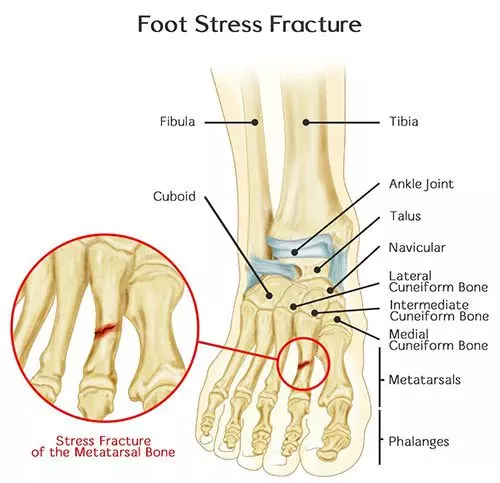What is a Foot Fracture?
Broken bones also called fractures in the foot are very common and in fact, about 1 out of every 10 broken bones occurs in the foot. One may experience a broken foot during a car crash or from a simple misstep or fall. The seriousness of a broken foot varies. Fractures can range from tiny cracks in the bones to breaks that pierce the skin.
Symptoms of Foot Fracture
Some of the signs and symptoms of a fracture include immediate throbbing pain, pain that increases with activity and decreases with rest, swelling, bruising, tenderness, deformity, and difficulty in walking or bearing weight.
Causes of Foot Fracture
A fracture, break, and crack all mean the same thing when it comes to a bone injury: the integrity of the bone has been damaged. The cause of injury may be obvious such as jumping from a height or a heavy object falling and landing on the foot or it may develop gradually over time, such as the result of the constant stress of walking or running.
Fractures of the calcaneus (heel bone) usually occur when a person jumps or falls from a height, landing directly on their feet. The force of the landing may also be transmitted up the body to cause fractures of the ankle, knee, hip, and lumbar spine. Injuries to the mid-foot, the metatarsals, and phalanges often are caused by a direct blow sustained when a kick goes awry or from a crush injury when a heavy object is dropped on the foot. Twisting injuries can cause bones to break. For example, fractures of the base of the fifth metatarsal occur when the ankle rolls inward and a fragment of the bone is pulled off (avulsed) by the peroneal tendon.
The most common causes of an injured foot include falls, crush injuries (including impacts from a heavy object or an automobile accident), missed steps, and stress/overuse injuries. In some cases, seeking care from a chiropractor in Singapore may help support recovery and restore mobility following a foot fracture.
Foot Fracture Treatment
In general, a foot fracture may take anywhere from 1 to 3 months to heal. A physical therapist can help the foot fracture to recover fully and back to normal function. Treatment for a fracture often focuses on overcoming the negative effects of being immobilised by a cast or sling. Immobilisation may cause loss of motion and strength and decreased functional mobility. Apart from manual therapy, exercises and modalities such as electro-therapy stimulation may be used to help with pain and swelling. Your therapist can help improve walking and incorporate functional activities that focus on reaching and grasping if needed. If surgery is done to reduce the fractured bone, scar massage and mobilisation can help reduce scar adhesions and improve mobility around the scar. Personalised exercises to improve range of motion and strength may also be prescribed. Particular focus should be placed on the fractured area and the joints around the fracture. If in doubt, please seek professional advice.
Recovering from a Foot Fracture?
If you’ve experienced a foot fracture, proper rehabilitation can support healing and prevent long-term complications. Visit our chiropractic clinic in Singapore to explore care options that may assist with your recovery and mobility.
Check out our popular articles: Diastasis Recti, Tight Back Muscles, Irritable Bowel Syndrome (IBS), Temporomandibular Joint (TMJ) Dysfunction, Tennis Elbow, Wrist Tendon Injury, Sciatica, Whiplash, Hernia, Herniated Disc (Slipped Disc).






